
The Cucurbitaceae, also called cucurbits or the gourd family, are a plant family consisting of about 965 species in 101 genera. Those of most agricultural, commercial or nutritional value to humans include:
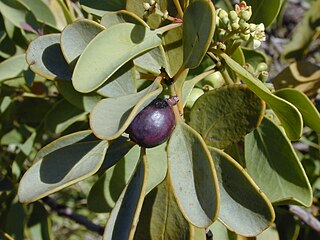
The Santalaceae, sandalwoods, are a widely distributed family of flowering plants which, like other members of Santalales, are partially parasitic on other plants. Its flowers are bisexual or, by abortion, unisexual. Modern treatments of the Santalaceae include the family Viscaceae (mistletoes), previously considered distinct.

Myrtaceae, the myrtle family, is a family of dicotyledonous plants placed within the order Myrtales. Myrtle, pōhutukawa, bay rum tree, clove, guava, acca (feijoa), allspice, and eucalyptus are some notable members of this group. All species are woody, contain essential oils, and have flower parts in multiples of four or five. The leaves are evergreen, alternate to mostly opposite, simple, and usually entire. The flowers have a base number of five petals, though in several genera, the petals are minute or absent. The stamens are usually very conspicuous, brightly coloured, and numerous.
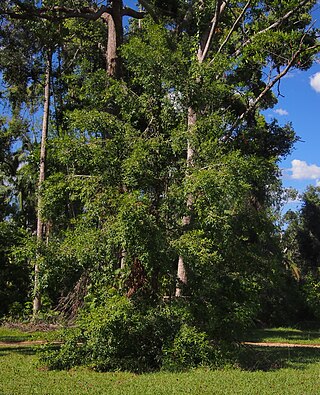
Podocarpaceae is a large family of mainly Southern Hemisphere conifers, known in English as podocarps, comprising about 156 species of evergreen trees and shrubs. It contains 19 genera if Phyllocladus is included and Manoao and Sundacarpus are recognized. The family achieved its maximum diversity in the Cenozoic, making the Podocarpaceae family one of the most diverse in the southern hemisphere.

The Celastraceae are a family of 98 genera and 1,350 species of herbs, vines, shrubs and small trees, belonging to the order Celastrales. The great majority of the genera are tropical, with only Celastrus, Euonymus and Maytenus widespread in temperate climates, and Parnassia (bog-stars) found in alpine and arctic climates.

The Rhamnaceae are a large family of flowering plants, mostly trees, shrubs, and some vines, commonly called the buckthorn family. Rhamnaceae is included in the order Rosales.
Sterculiaceae was a family of flowering plant based on the genus Sterculia. Genera formerly included in Sterculiaceae are now placed in the family Malvaceae, in the subfamilies: Byttnerioideae, Dombeyoideae, Helicteroideae and Sterculioideae.

Cordyline is a genus of about 24 species of woody monocotyledonous flowering plants in family Asparagaceae, subfamily Lomandroideae. The subfamily has previously been treated as a separate family Laxmanniaceae, or Lomandraceae. Other authors have placed the genus in the Agavaceae. Cordyline is native to the western Pacific Ocean region, from New Zealand, eastern Australia, southeastern Asia and Polynesia, with one species found in southeastern South America.

Acanthus is a genus of about 30 species of flowering plants in the family Acanthaceae, native to tropical and warm temperate regions, with the highest species diversity in the Mediterranean Basin and Asia. This flowering plant is nectar-producing and depends on butterflies, such as Anartia fatima, and other nectar-feeding organisms to distribute its pollen. Common names include Acanthus and bear's breeches. The generic name derives from the Greek term ἄκανθος (akanthos) for Acanthus mollis, a plant that was commonly imitated in Corinthian capitals.
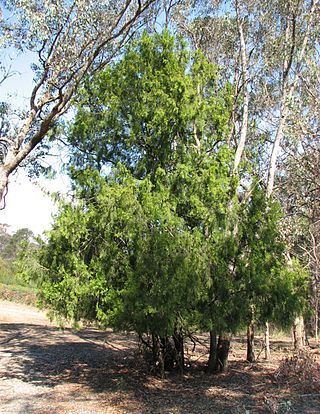
Exocarpos is a genus of flowering shrubs and small trees in the sandalwood family, Santalaceae. They are found throughout Southeast Asia, Australia and the Pacific Islands.
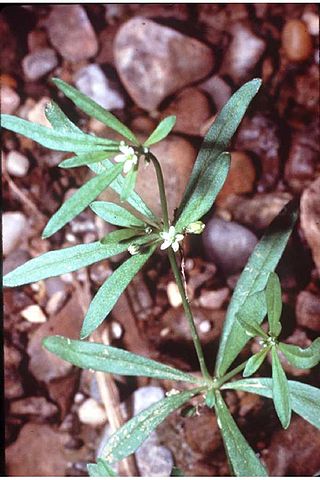
The Molluginaceae are a family of flowering plants recognized by several taxonomists. It was previously included in the larger family Aizoaceae. The APG III system of 2009 made no change in the status of the family as compared to the APG II system of 2003 and the APG system of 1998, apart from a reassignment of several genera, such as the placement of Corrigiola and Telephium into Caryophyllaceae, Corbichonia in Lophiocarpaceae, Microtea into Microteaceae and Limeum in Limeaceae, because the family was found to be widely polyphyletic in Caryophyllales. In addition Macarthuria was found not to be related to Limeum as previously thought and thus it was placed in Macarthuriaceae, and similarly species formerly placed in Hypertelis, apart from type species Hypertelis spergulacea, a true Molluginaceae, were found to belong elsewhere and were described as Kewa in the family Kewaceae, named for the Royal Botanic Gardens Kew. Molluginaceae is still assigned to the order Caryophyllales in the clade core eudicots, although the generic circumscription is difficult because Mollugo is not monophyletic.

The Balanophoraceae are a subtropical to tropical family of obligate parasitic flowering plants, notable for their unusual development and formerly obscure affinities. In the broadest circumscription, the family consists of 16 genera. Alternatively, three genera may be split off into the segregate family Mystropetalaceae.
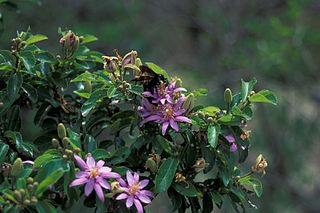
Grewioideae is a subfamily of the family Malvaceae and was first described by Hochreutiner. The group is named after its type genus, Grewia, which is named for the English scientist Nehemiah Grew (1641–1712). It contains a number of genera that were previously placed in the defunct family Tiliaceae.
Mead Island is an uninhabited sand island located about 200 metres from Dirk Hartog Island in the Shark Bay World Heritage Site in Western Australia, and joined to that island at low tide. It has an area of about 800 square metres, and an elevation of two metres (7 ft).

Rumex longifolius, commonly known as the dooryard dock or northern dock, is a perennial species of plant in the genus Rumex.

Chamelaucieae is a tribe of flowering plants within the family Myrtaceae, mostly from Australia, with a few species in New Caledonia and south-east Asia.

Exocarpos latifolius is a species of parasitic tree, in the plant family Santalaceae. They have the common names broad leaved ballart, scrub sandal-wood, scrub cherry, oringorin, broad leaved cherry or native cherry. The species is found in monsoon forest, littoral rainforest and occasionally in more open forest types in Malesia and across Northern Australia.

Isopogon longifolius is a species of flowering plant in the family Proteaceae and is endemic to the southwest of Western Australia. It is a shrub with simple, linear, or deeply divided leaves and sessile, spherical heads of silky-hairy, yellow flowers and spherical to oval cone.

Exocarpos aphyllus belongs to the sandalwood plant family (Santalaceae). Noongar names are chuk, chukk, dtulya and merrin. It is a species endemic to Australia.
Paragramma is a genus of ferns in the family Polypodiaceae, subfamily Microsoroideae according to the Pteridophyte Phylogeny Group classification of 2016 (PPG I). There is a single species, Paragramma longifolia. Other sources do not accept the genus, submerging it into Lepisorus, with Paragramma longifolia becoming Lepisorus longifolius(Blume) Holttum. A molecular phylogenetic study in 2019 showed that Lepisorus longifolius was sister to all the remaining species of Lepisorus, which formed a clade.
















